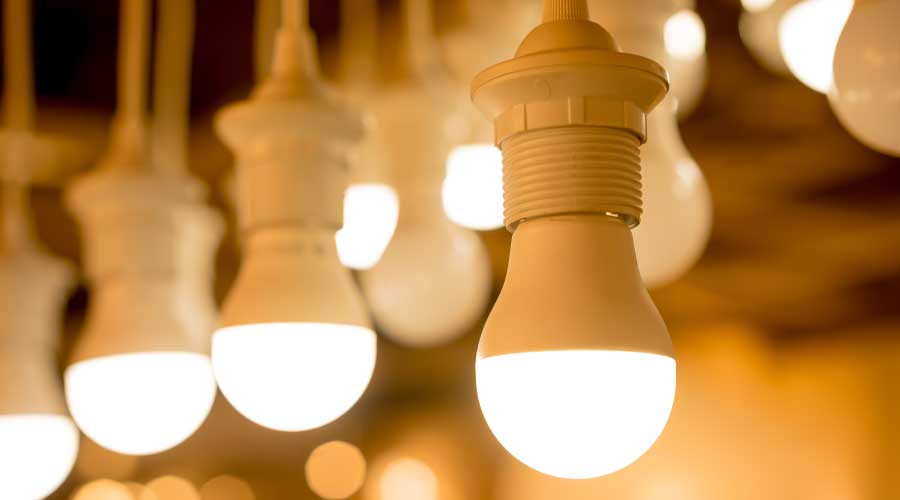Ballasts Can Renew Lighting’s Shine
The latest electronic ballasts are efficient and flexible, allowing facility executives to do more with lighting systems
By Brandon Lorenz, Senior Editor
Facilities that have undergone a lighting retrofit within the past decade still have opportunities to make improvements when it comes to operational costs and functionality. How much a facility stands to gain depends on how recently the ballasts were upgraded.
New electronic ballasts are more efficient and give facility executives more flexibility to use lighting controls — including dimmers — in connection with fluorescent lamps. The new technologies can bring gains to facility executives who installed ballasts as recently as five years ago.
New electronic ballast systems can be more than 90 percent efficient, says Jeffrey Plaskon, North America ballast product manager for G.E. Lighting. When properly applied, new ballast and lamp technology can offer improvements to first-generation T8 systems, and they offer substantial benefits to facilities that have retained magnetic ballasts and T12 lamps.
“If it was magnetically ballasted, there is no doubt the best answer is for the facility executive to upgrade to third-generation technology,” says Bill Brosius, director of specification sales for Universal Lighting. “The movement is to standardized high-efficiency electronics.”
Facility executives who replace early T8 systems with new electronic ballasts and lamps won’t find the same kinds of savings as when they made the switch from T12 to T8. But new ballasts also offer facility executives control options that were unavailable previously. “The key right now is the controllability of the light,” says Bob Weathers, manager for Sylvania Lighting Services. “Why have a light on when you don’t need it? You can turn it on and off and dim it.”
Part of the drive behind dimming ballasts is California’s Title 24 energy requirements, which requires light loads to be cut in half during peak energy periods, says Brosius. Rather than turn off half the lights in a facility, dimming ballasts can turn all the lights down by 50 percent, which offers lighting that is more even while still meeting Title 24 rules.
Finding a Match
Ten years ago, dimming ballasts were sometimes based on proprietary technology, says Tom Leonard, director of marketing and product management for Leviton. Today, dimming ballasts are more common and based on technology that allows them to interface with lighting controls.
A word of warning: Facility executives should make sure to match the proper lamp and dimming ballast. In most cases, only a full-output 32 watt T8 lamp is guaranteed to work in dimming applications, says Doug Stoneman, senior product manager for Advance. In years past, ballast and lamp selection was relatively simple because there were fewer choices on the market.
“The selection of ballasts and lamps is more complicated than it used to be,” says Ken Walma, product manager at Lutron. “Facility executives need to pay more attention to selection.”
Matching lamps with the proper ballasts is especially important when occupancy sensors are used. In the past, a common choice was to combine an occupancy sensor with an instant-start ballast and a standard T8 lamp. In an instant-start ballast, the lamp electrodes are unheated, which uses less energy than other designs. To make up for the lack of heating, the instant-start ballast uses a higher starting voltage. Such a choice might not be appropriate for a system that uses occupancy sensors because the instant-start ballasts put more wear on the lamps, shortening their life.
“If you deal with an instant-start ballast and you use occupancy sensors, if you turn these lamps on and off two or three times an hour, you will decrease lamp life,” says Weathers. When occupancy sensors are used, a programmed-start ballast is one option. In programmed-start ballasts, the ballast heats the lamp electrodes and then applies the starting voltage, reducing wear on the lamp. Programmed-start ballasts are slower than instant-start, but the change is not significant to end users, says Brosius: about 50 microseconds for instant-start versus a half to 3⁄4 of a second for programmed-start. Programmed start ballasts also work well in dimming applications, because as a lamp is dimmed, the electrodes cool. Programmed-start ballasts can heat the electrodes as they cool, prolonging lamp life.
Facility executives shouldn’t be dissuaded by the challenges of occupancy sensors. Properly equipped, the systems can be a tool for trimming energy consumption, says Leonard. “It’s true that a lamp has a finite number of starts in it,” he says. “An occupancy sensor makes sure those hours are used when the room is occupied and not when it is vacant.”
What’s more, even if a lamp burns for fewer hours because it is turned on and off frequently, it may well last longer before it needs to be replaced. The reason: the lamp is turned off much more often, so the hours of illumination are extended over a longer period of time.
New technology has made its way to the high-intensity discharge arena as well. New pulse-start systems can improve the lumen maintenance and efficacy of the lamp system when compared to probe-start systems, says Tim Taubert, leader, electronic products engineering, Venture Lighting International.
Stretching Out Lumens
In the past, the common setup was a probe-start system, which used a magnetic ballast. A 400 watt probe-start system has an initial rating of 36,000 lumens and a mean lumen rating of 23,400 lumens. A new 400 watt pulse-start system also uses a magnetic ballast with an igniter to start the lamp. The pulse-start system has a rating of 44,000 initial lumens and a mean rating of about 35,000 lumens — roughly 80 percent, Taubert says. The brightness of fluorescent and metal halide lamps varies over their life cycle. The mean lumens rating describes the average lumens over the lamp’s life cycle.
Another new option for metal halide includes electronic ballasts, both for low-frequency and high-frequency lamps up to 450 watts. Electronic HID ballasts were first produced for low-frequency lamps because they are easier to start and cooler to operate, which made it easier to design electronic ballasts. Electronic ballasts can offer better controllability, improved lumen maintenance and higher system efficacy, Taubert says. Electronic HID ballasts can be between 3 percent and 12 percent more efficient than magnetic ballasts. What’s more, using electronic ballasts means HID lamps can be dimmed.
“Ten years ago, dimming was around, but the lamps weren’t designed to dim to lower levels,” says Michael Minarczyk, manager of electronics engineering, Holophane. “The systems had thermally sensitive metals that were designed to operate at full wattage.” Now, lamps are approved by the lamp manufacturers to dim to 50 percent using electronic ballasts.
New ballasts for fluorescent lamps that can support a wider range of voltages — called adaptable ballasts — can simplify maintenance and inventory stocking, says Stoneman.
Adaptable ballasts are also less sensitive to power fluctuations, Plaskon says.
Choosing Wisely
With the introduction of occupancy sensors, dimming ballasts, and T8 lamps that save energy compared to a standard 32 watt T8 lamp, it becomes all the more important for facility executives to make the proper ballast selection. Poor selection means that a system may not operate as envisioned — lamps could require frequent replacement or light output might not match projections.
One approach is to standardize a lamp, but vary the ballast based on the specific needs of the space being lit. “It’s difficult to pick a one-ballast strategy,” says Walma. “If you put the onus on the ballast manufacturer to guarantee that its ballasts will work with a lamp or list of lamps, not just their own, you can guarantee proper operation.”
Another strategy is to consider a system approach for the lamp and ballast. Some manufacturers are starting to optimize their lamps and ballasts to work together. Using one manufacturer for both the lamp and ballast also has the potential to reduce hassles in the event of a problem.
“Facility executives should treat lighting as a system just as they would air conditioning or any other system in a building,” says Minarczyk. “As the technology is evolving around high-efficiency systems, if you want a high-performance system, you can’t just pick a ballast and pick a lamp from a catalog and optimize for cost.“
While technology such as occupancy sensors and programmed-start ballasts has been around for some time, the technology has not been rapidly adopted in retrofit applications. “The biggest change isn’t the product or product efficiency,” says Brosius. “It’s the overall system replacement costs and the labor associated with the change.” Control wiring for dimming, for example, is an added cost to install in retrofit applications.
The same is true regarding HID systems. “Despite their comprehensive benefits, electronic HID technology is in the early stages of adoption,” says Stoneman. Probe-start systems are still common, despite the fact that pulse-start ballasts are more efficient, says Taubert.
Two-Year Opportunity
The Energy Policy Act (EPACT) of 2005 could provide an incentive to upgrade. The law allows companies that upgrade lighting systems to receive a tax deduction. For lighting systems, an upgrade that reduces power by 25 percent below ASHRAE 90.1.2001 and has the ability to cut lighting power by half while keeping uniform light distribution would qualify for a deduction of 30 cents per square foot. With the exception of warehouses, reducing power by 40 percent below ASHRAE 90.1.2001 requirements could qualify for a deduction of up to 60 cents per square foot, according to the Tax Incentive Assistance Project. The deduction only applies to systems that are installed before Dec. 31, 2007.
The tax deductions mean facility executives may be able to undertake a lighting upgrade and see a payback on the system within two years, says Weathers.
While research is always ongoing, energy codes such as California’s Title 24 will help push new technology from the lab to market. “Energy codes are now forcing new construction to employ state-of-the-art lighting technology to achieve the lighting power density needed to meet code,” says Leonard. Starting in 2008, for example, probe-start metal halide systems will not be allowed for installation in California, Minarczyk says.
Another issue is heat — some new ballasts include sensors that can detect when the ballast is overheating and automatically dial back the power needed to keep lighting output consistent. But heat will remain an area where work needs to be done, says Walma. T5 lamps, for example, are more sensitive to temperature changes than T8 systems.
With new dimming ballasts, occupancy sensors, new energy-saving T8 systems, and potential tax deductions available for lighting upgrades in EPACT, facility executives may not need to wait for new technology before considering a lighting upgrade. “Now more then ever, it’s critically important to learn about available technologies and strategies for lowering energy costs,” says Plaskon.
Related Topics:











